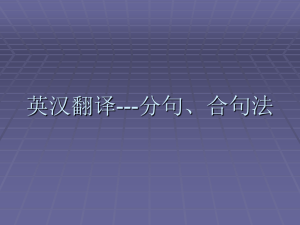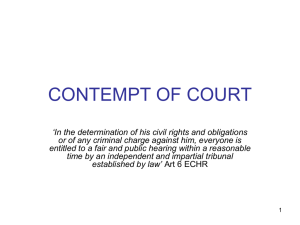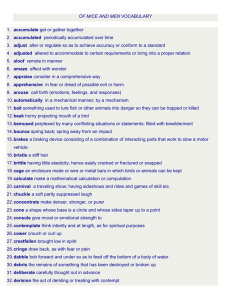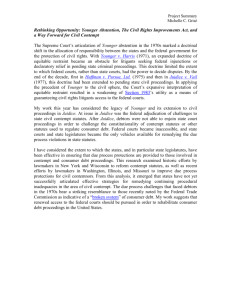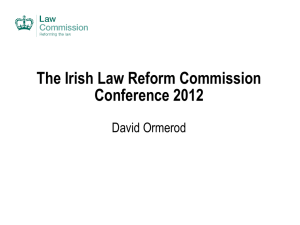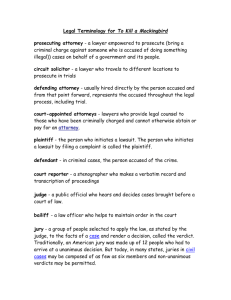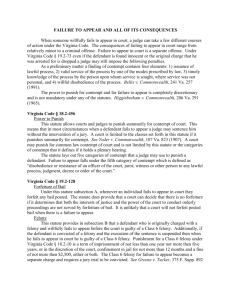contempt of court - Texas Municipal Courts Education Center
advertisement
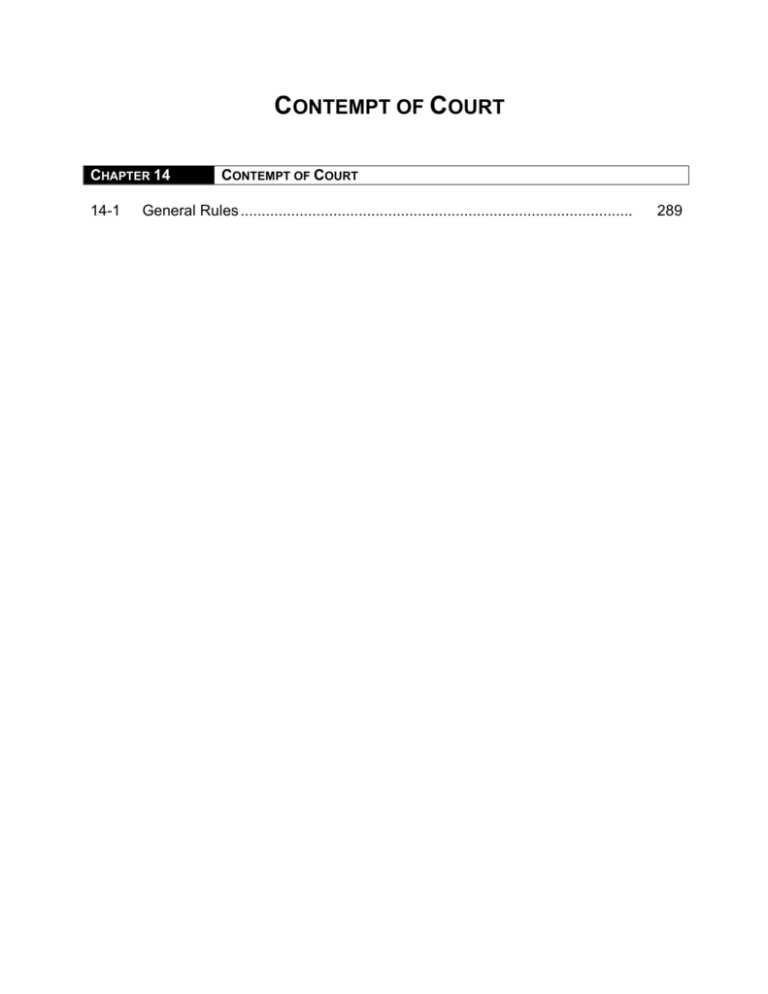
CONTEMPT OF COURT CHAPTER 14 14-1 CONTEMPT OF COURT General Rules ............................................................................................. 289 TMCEC Bench Book CHAPTER 14 CONTEMPT OF COURT 1. General Contempt The contempt power of the court should be used sparingly. A person accused of contempt has the rights of a criminal defendant, regardless of whether the contempt is considered civil or criminal (discussed below). A more thorough discussion of contempt of court is contained in Chapter 5 of TMCEC The Municipal Judges Book. Juvenile contempt under Article 45.050, C.C.P., is covered in Checklist 1327. Checklist 14-1 Script/Notes Definitions: “Contemnor” is a person held in contempt. “Contempt”: Although there is no statutory definition of contempt, common law defines it as conduct that tends to impede the judicial process by disrespectful or uncooperative behavior in open court or by unexcused failure to comply with clear court orders. Ex parte Norton, 191 S.W.2d 713 (Tex. 1946). 1. Contempt can be direct or indirect. Ex parte Chambers, 898 S.W.2d 257 (Tex. 1995). 2. “Direct contempt” is an act which occurs in the judge’s presence and under circumstances that require the judge to act immediately to quell the disruption, violence, disrespect, or physical abuse. “Presence of the court” does not necessarily mean in the immediate presence of the judge or court. Examples of direct contempt may include: Ex parte Knable, 818 S.W.2d 811 (Tex. Crim. App. 1991). a. A physical altercation occurring at the door of the courtroom although the court was not able to see the physical act itself; Ex parte Daniels, 722 S.W.2d 707 (Tex. Crim. App. 1987). b. Disruptive act or event in the courtroom or just outside the courtroom while court is in session; Ex parte Aldridge, 334 S.W.2d 161 (Tex. Crim. App. 1959). c. Refusal to rise on the entrance and exit of the judge; Ex parte Krupps, 712 S.W.2d 144 (Tex. Crim. App. 1986). d. Tampering with jurors in the jury room; e. An abusive letter delivered to the judge in chambers while trial was in short recess; or f. Refusal to answer questions in court. Chapter 14 - Contempt of Court 289 Ex parte Flournoy, 312 S.W.2d 488 (Tex. 1958). August 2011 TMCEC Bench Book Note that an affront to a judge’s personal sensibilities should not be confused with obstruction to the administration of justice. Offensive comments, even though spoken in open court, are not contemptuous unless they are disruptive or boisterous. 3. In many instances, direct contempt is punished summarily by the offended court at the time the act occurs. However, there is no requirement that direct contempt be punished immediately; a judge has discretion to set the matter for hearing at a later time. The trial court’s authority to punish contemptuous conduct summarily requires an act which occurs in the judge’s presence and under circumstances that require the judge to act immediately to maintain order. If the contemnor can be afforded due process protections without disrupting the orderly trial process, the Due Process Clause of the Fourteenth Amendment mandates that the contemnor should be afforded these protections. In re Bell, 894 S.W.2d 119 (Tex. 1995). See Ex parte Knable, 818 S.W.2d 811 (Tex. Crim. App. 1991). 4. “Indirect contempt” is an act that occurs outside the court’s presence. Examples of indirect contempt include: a. Failure to comply with a valid court order. Ex parte Gordon, 584 S.W.2d 686 (Tex. 1979). b. Failure to appear in court. Ex parte Cooper, 657 S.W.2d 435 (Tex. Crim. App. 1983). c. Attorney being late for trial. Ex parte Hill, 52 S.W.2d 367 (Tex. 1932). d. Offensive papers filed in court. Ex parte O’Fiel, 246 S.W. 664 (Tex. Crim. App. 1923). 5. Indirect contempt requires the contemnor to be notified of the charges, the right to trial or hearing in open court, and the right to counsel. See TMCEC Forms Book: Show Cause Notice: Adult or Juvenile. 6. Contempt can be civil or criminal: Civil contempt is willfully disobeying a court order or decree. Ex parte Powell, 883 S.W.2d 775 (Tex. App.—Beaumont 1994). Criminal contempt is an act that disrupts court proceedings, obstructs justice, is directly against the dignity of the court, or brings the court into disrepute. See Step 15: Sentencing Goals. 7. Statutory Authority for Contempt Proceedings Chapter 14 - Contempt of Court 290 August 2011 TMCEC Bench Book a. In municipal courts, contempt is generally punishable by up to three days confinement in jail and/or a fine up to $100. Sec. 21.002(c), G.C. b. Some statutes provide for specific contempt fines and do not allow confinement in jail: (1) Failure by sheriff or officer to execute summons, subpoena, or attachment is punishable for contempt by a fine of $10 to $200. Art. 2.16, C.C.P. (2) Failure to appear for jury duty is punishable for contempt by a maximum fine of $100. Art. 45.027(c), C.C.P. See TMCEC Forms Book: Contempt: Failure to Appear for Jury Service (Complaint and Judgment). 8. Special Procedures for Officers of the Court Officers of the court include attorneys, peace officers, clerks, bailiffs, court reporters, interpreters, and others on whom the court relies for its operation and enforcement of its orders. Note: the defendant and witnesses are not officers of the court. a. Upon proper motion, release contemnor on personal recognizance bond. Sec. 21.002(d), G.C. b. Refer case to the presiding judge of the administrative district where alleged contempt occurred. The presiding judge will assign a judge to conduct a contempt hearing. (You may be called as a witness.) c. An officer of the court is essentially entitled to a trial de novo on request. Ex parte Avila, 659 S.W.2d 443 (Tex. Crim. App. 1983). d. An attorney may be held in direct contempt primarily for misconduct at trial: (1) Expressing indifference to what court may hold or do on account of his or her improper remarks and misconduct. Ex parte Norton, 191 S.W.2d 713 (Tex. 1946). (2) Making continuous frivolous objections amounting to obstruction of the orderly progress of the trial. Ex parte Crenshaw, 259 S.W.587 (Tex. Crim. App. 1924). Chapter 14 - Contempt of Court 291 August 2011 TMCEC Bench Book 9. Determine whether act constitutes direct or indirect contempt. a. Direct contempt (1) Act occurred in the presence of the court or in its immediate vicinity while the court was in session. Judge is aware of all facts constituting contempt. If both of these conditions are met, summary proceedings are authorized and you may go to Step 10: Direct Contempt Procedure below. (2) Immediate action is necessary to quell disruption, violence, disrespect, or to allow trial or proceeding to continue. b. Indirect contempt (1) Act occurred outside the presence of the court. Judge does not personally witness act. Due process requires notice and hearing. Go to Step 11: Indirect Contempt Procedure below. (2) Immediate action is not required to quell disruption, violence, disrespect, or physical abuse. (3) Act requires testimony or production of evidence to establish its existence. (4) Most common violation — disobeying a court order: (a) Court order must be in effect at the time of the act; (b) Contemnor must be aware of the order; and (c) A written order must be served on the contemnor. 10. Direct Contempt Procedure a. If the act is in disobedience to a court order or admonishment, and the contemnor disobeys or fails to cease the undesirable conduct: (1) Announce that contemnor is in Chapter 14 - Contempt of Court 292 See TMCEC Forms Book: Judgment of Direct Contempt: Adult. Example: Any act that disrupts court proceedings or offends the dignity of the court. Contemnor argues combatively, uses curse words or threatening acts. Factors to consider: egregious August 2011 TMCEC Bench Book contempt of court. conduct; danger if contemnor not immediately removed. (2) Optional: Give contemnor opportunity to explain: (a) If explanation is not accepted or if conduct persists, contempt exists. Announce “You are in contempt of court.” Sec. 21.002(c), G.C. See Step 13 below. (b) If explanation is accepted, no contempt. 11. Indirect Contempt Procedure Skip rest of this section. See TMCEC Forms Book: Judgment of Contempt for Disobeying a Court Order: Adult. a. If disobedience to a court order is alleged, notice to contemnor must: See TMCEC Forms Book: Show Cause Notice. (1) Contain the order; (2) Specify when and how contemnor was notified of the order; (3) Specify contemnor’s alleged act in disobedience of the order; (4) Specify when and where act occurred; and (5) Specify that the act took place after the contemnor became aware of the order. b. Otherwise, notice must: (1) Specify contemnor’s alleged contemptuous act; and (2) Specify when and where act occurred. 12. Right to Counsel a. Contemnor has right to have counsel represent him or her. Chapter 14 - Contempt of Court 293 August 2011 TMCEC Bench Book b. Appoint counsel to represent contemnor if: (1) the contemnor is indigent; and (2) jail time is imposed as part of contempt punishment. Ex parte Goodman, 742 S.W.2d 536 (Tex. App.—Fort Worth 1987). Appointed counsel is not necessary for contempt punishment limited to fine-only sanctions under Arts. 2.16 and 45.027(c), C.C.P. 13. Contempt Hearing for Direct Contempt a. An act of direct contempt occurring in the presence of the court generally requires neither notice nor hearing since there is no factual dispute concerning the contemptuous conduct. Contemnor may be convicted and sentenced for the direct contempt as it occurs. Ex parte Krupps, 712 S.W.2d 144 (Tex. Crim. App. 1986). b. Summary punishment is permissible on the theory that immediate action is necessary to control courtroom proceedings. If the court postpones conviction and punishment until after the trial, for example, the justification for dispensing with due process requirements disappears. Ex parte Smith, 467 S.W.2d 411 (Tex. Crim. App. 1971). If a contemnor is summarily held in contempt, the fact that the court waits a day to enter the contempt order does not affect its validity. See Step 15 below. 14. Contempt Hearing for Indirect Contempt a. Since indirect contempt involves an offense not observed by the court, due process requires the contemnor to be given notice and hearing. b. If disobedience to a court order is alleged: (1) Provide evidence contemnor was properly notified of the order; (2) Provide evidence contemnor willfully disobeyed the order after notified of it; and (3) Provide evidence for no satisfactory explanation or defense for disobedience. Possible defenses include: court lacks personal or subject matter jurisdiction; order of court lacked clarity or specificity or was ambiguous; contemnor not given adequate notice; and order was not based on same acts set forth in charge of contempt. c. If court order not involved: Chapter 14 - Contempt of Court 294 August 2011 TMCEC Bench Book (1) Provide evidence contemnor committed the alleged act; and (2) Provide evidence for no satisfactory explanation or defense for act. d. Ensure contemnor’s constitutional rights are protected: (1) Right to counsel; (2) Right to confront and cross-examine witnesses; (3) Privilege against self-incrimination; (4) Protection against double jeopardy; and (5) Right to public trial. There is no right to trial by jury in most contempt hearings. Texas courts generally have the right to adjudicate contempt proceedings without a jury. Ex parte Werblud, 536 S.W.2d 542 (Tex. 1976). Contemnor is entitled to a jury trial if the contempt is classified as a serious rather than petty offense. One factor in determining whether the offense should be treated as serious or petty is the amount of the fine imposed. The imposition of a minor fine does not elevate the offense from the classification of petty to a serious crime. Ex parte Werblud, 536 S.W.2d 542 (Tex. 1976). 15. Sentencing Goals a. Civil Contempt. Ex parte Werblud, 536 S.W.2d 542 (Tex. 1976). Purpose of civil contempt is remedial and coercive in nature. Judgment of civil contempt exerts the judicial authority of the court to persuade the contemnor to obey some order of the court where such obedience will benefit an opposing litigant. Chapter 14 - Contempt of Court 295 August 2011 TMCEC Bench Book b. Criminal Contempt (Punitive) Ex parte Werblud, 536 S.W.2d 542 (Tex. 1976). The sentence is not conditioned upon some promise of future performance because the contemnor is being punished by fine and imprisonment for some completed act that affronted the dignity and authority of the court. Examples: disruptive conduct that prevents trial from proceeding; attempting to bias jury panel by handing them pamphlets. 16. Order and Commitment a. Describe the act found to be in contempt. See TMCEC Forms Book: Judgment of Direct Contempt: Adult; and Judgment of Contempt for Disobeying a Court Order: Adult. b. If act was disobeying a court order: (1) Include written order or reduce verbal order to writing. (2) Specify when and how contemnor was notified of the order. (3) Specify that the act was in disobedience of the order. (4) State that the act was committed after contemnor was aware of the order. c. Remedial Sanction: (1) Specify exactly what contemnor must do to purge the contempt. (2) Order sheriff or chief of police to place person in jail. (3) If contemnor purges himself or herself of contempt, order his or her release. d. Punitive Sanction: (1) Specify the punishment. (2) If jail time is part of punishment, order sheriff or chief of police to place contemnor in jail for specified time. Chapter 14 - Contempt of Court 296 No particular form is required for commitment. Directive that a person be placed in jail and detained may be contained in an authenticated copy of the court’s order. Ex parte Barnett, 600 S.W.2d 252 (Tex. 1980). Normally, maximum punishment is three days and $100. Check specific statutes; some authorize fine-only. See Arts. 2.16 and 45.027(c), C.C.P. August 2011 TMCEC Bench Book (3) If fine is part of punishment, order contemnor to pay fine by a specific date. (4) If more than one act of contempt, specify a separate punishment for each act. Chapter 14 - Contempt of Court 297 Punishment should be assessed for each act even if sentences run concurrently. If one punishment is assessed for multiple acts and one of those acts is not contempt, the entire judgment is void. Ex parte Lee, 704 S.W.2d 15 (Tex. 1986). August 2011 TMCEC Bench Book This page intentionally left blank Chapter 14 - Contempt of Court 298 August 2011
